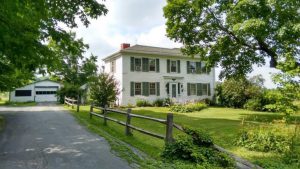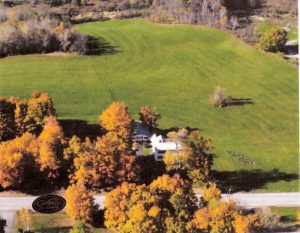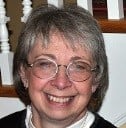 A few years ago, when I first began to make quiet rumblings about selling My Old House and moving closer to my son, most people reacted with horror, surprise, and objections: “You wouldn’t really!” “Would you really sell it?” “What would your father, mother, grandparents say?” “Good Grief, sell your Old House?!”
A few years ago, when I first began to make quiet rumblings about selling My Old House and moving closer to my son, most people reacted with horror, surprise, and objections: “You wouldn’t really!” “Would you really sell it?” “What would your father, mother, grandparents say?” “Good Grief, sell your Old House?!”
I would. I will! (Cash and certified checks accepted!)
I come from a long line of dairy farmers who had their colonial beginnings in various counties in Massachusetts and New Hampshire (no sea captains with magnificent coastal mansions here, darn it). Most arrived in the early- and mid-1630s, travelled in packs, and came mostly from the same counties in England. Gradually, over the following centuries, they moved north until they meshed with another family line coming into Maine from Scotland by way of Canada.
Most of them are buried in the cemetery a few hundred yards from My Old House.
By 1777 my ancestors had bought their land, and by 1789 they had built My Old House and established a long family ownership of our two homesteads here, passing title from father to son to cousins to daughters. Most of them are buried in the cemetery a few hundred yards from My Old House. My brother sold our great-great-great-great-grandfather’s home and abutting land in December 2015 to move nearer his daughter in North Carolina. Now this remaining descendant and her family plan to move “south” to live nearer her son, back to the Massachusetts and New Hampshire areas where her family’s American history has its roots.
I inherited My Old House from my mother in 2005, continuing 228 years of family possession. Although I grew up here, I had little expectation that I would continue to work it as a farm. Instead, I wanted to preserve this historic property, the oldest unaltered residence in Augusta, for my children to inherit, to become more self-sufficient in daily living, to make my ancestors proud of me for telling their stories, and to continue family traditions in land management and “gentleman” farming. It is so much a part of me that if I took a DNA test now, the results would probably reveal a new haplogroup called “old house.”
There are some original door latches and some original doors, wood-covered corners in the front rooms...
We restored the oldest section of the house to something more like the original, and reused all but about a square foot of the original wood. In addition to its lengthy history as a family homestead, the house has an uncommon amount of original materials, from 28”-wide wainscoting planks, 10-12”-wide floorboards, and 8” square oak beams to the gunstock corner in the bathroom and the 1820s wallpaper in an upstairs bedroom closet.
There are some original door latches and some original doors, wood-covered corners in the front rooms, a pit-sawn door to the attic, original lightning rods, and large door hinges made in the original forge in back of the shed. The double fireplaces are supported by huge quarried granite blocks, and the foundation is a combination of similar quarried granite blocks, boulders, and bricks, all solid and surprisingly tight. But perhaps most surprising is that this 1789 house and its 1820s front section were built with closets, truly useable, deep closets with shelves, along with cabinets above or on either side of the fireplaces.
I built raised beds for gardens, slicing a sidewall on a good tire in the process of hauling timbers. (I was told that my SUV isn’t a John Deere even if it’s green!) I grew vegetables in those beds for a few years until I realized I grew better weeds than food. We leased the fields to a local, big production farmer who quickly made me realize that farming methods today are not my ancestors’ methods. We logged the “back 40” according to good forest management ideas; the scrub-brush and poison ivy grew back in less than four years. The wildlife is happy with it, though.
 We posted our forty-three acres for “no hunting” to give the coyote, deer, bear, moose, beaver, ducks, and even a rogue skunk refuge of sorts, but unfortunately there is a need to police the property. The idea that the no trespassing and no hunting signs “mean everybody but me” is prevalent, and I lack the wherewithal to watch over multiple acres I can’t see from my kitchen window.
We posted our forty-three acres for “no hunting” to give the coyote, deer, bear, moose, beaver, ducks, and even a rogue skunk refuge of sorts, but unfortunately there is a need to police the property. The idea that the no trespassing and no hunting signs “mean everybody but me” is prevalent, and I lack the wherewithal to watch over multiple acres I can’t see from my kitchen window.
Dad never told me about these things. He spent his career as a Federal meat inspector commuting to and from Boston every week, spending every weekend keeping the two family farms going and depending on my older brother or hired help to work it in his absence. He taught me to drive the hay truck and a tractor to rake the hay fields, to feed the cows and horses, to saddle and ride a horse (but not how to stay on!), to bring the cows in from pasture for milking, and to pile the hay bales in the barn. Mom taught me gardening, painting and wallpapering, crochet, music and piano, how to properly set a formal dinner table, and how to not wait for Dad to put up the new clothesline.
I’ve done my best, made my mistakes, learned a great deal about what I want at this stage of life...
My children have found their own roots and happy lives in Massachusetts, near where their great-great-great-great-great-great-great-great-grandparents settled, and reluctantly decline to disrupt life to move to Maine just to keep My Old House in the family. I’m beginning to suspect my ancestors are at work in this process: the more I review my family tree, the more early ancestors I find in the earliest Massachusetts towns.
If anyone thinks that I’m saying I’ve failed, not so. I’ve done my best, made my mistakes, learned a great deal about what I want at this stage of life, and, most importantly, I’ve made my peace with my ancestors by restoring and respecting their home and property. Goodbye Yellow Brick Road; I’ve had what I needed all along, and I won’t have to click my heels three times to find home.
This is MY Old House, not my ancestors’, in an age drastically different from my parents’ era. Their expectations and hopes for this property are neither anchor nor albatross for me or my descendants as I now plan to sell the property out of the family, for the first time ever, to move on to new beginnings. I will always be a Church-Cony-Read-Lee-Libby-Saunders-Williams descendant but no longer a farmer’s daughter, walking among the gravestones, standing among the ashes of my ancestors who might finally, finally let me go . . . back to their beginnings and my new old home.
My Old House does come with chains, those that have bound me to it through my family and my lineage. Now it is time for someone else to forge a new chain, to begin a new lineage, and to add a new chapter to the story of My Old House.
Share this:

About Jan Doerr
Jan Doerr received a B.A. degree in Sociology/Secondary Education from the University of New Hampshire, and spent a long career in the legal profession while researching her family history. She has recently written and published articles for WBUR.org’s Cognoscenti blog: “Labor of Love: Preserving a 226-Year-Old Family Home and Preparing to Let It Go” and “The Value of Family Heirlooms in a Digital Age.” Jan currently lives with her attorney husband in Augusta, Maine, where she serves two Siamese cats and spends all her retirement money propping up a really old house.View all posts by Jan Doerr →